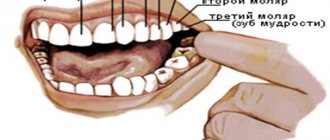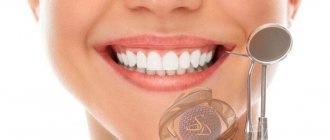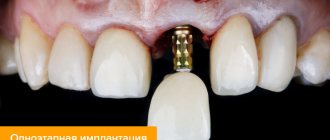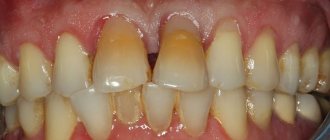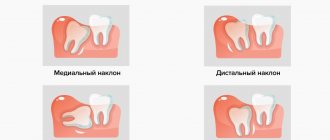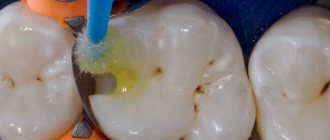Increased tooth abrasion is a process of increased tissue loss: first, the enamel becomes thinner, and then the inside of the teeth. Typically, the process of abrasion is constant - teeth gradually wear out throughout human life: first, the tooth enamel becomes thinner, and in old age it comes to the inner layers. Increased abrasion is a similar process that occurs at an accelerated rate: a real problem, and we will tell you how to deal with it.
The pathological loss of dentin and enamel is different in that it occurs much faster than with normal physiological abrasion. In this case, we talk about abnormal tooth wear, which is a recognized dental problem that mainly affects men over the age of 30. In this case, the decrease in the dental layer begins gradually, and as it progresses, it is no longer possible to influence the disease or cure it. That is why it is extremely important not to miss the initial stage of destruction of tooth enamel - so that tooth extraction, treatment and prosthetics are not required.
As a result, pathological abrasion of teeth occurs
The pathogenesis of the disease involves several factors, both external and internal.
| Endogenous factors | Exogenous factors |
| Metabolic disease. Gastrointestinal diseases. Pathology of the endocrine system. Bruxism (teeth grinding). | Patient's nutrition. Nature of working conditions. Incorrect prosthetics. |
The greatest influence on the abrasion process itself is exerted by occlusal forces, which have the following characteristics:
- The amount of chewing force. It is determined by the strength of the masticatory muscles, which can range from 80 to 400 kg. It is necessary to take into account that teeth are under stress not only when chewing food, but also when swallowing, and a person performs several thousand swallowing movements per day.
- Duration. During the day, the occlusal surfaces of the teeth come into contact with each other for half an hour, but with pathology, this figure can increase significantly.
- Application point and direction. The occlusal force is directed at right angles to the chewing surface of the tooth. Normally, the contact area is several square millimeters, but with pathology it can increase several tens of times, which leads to greater efforts when chewing.
In the presence of harmful production factors, bruxism, fluorosis and other reasons mentioned above, all characteristics of occlusal forces change for the worse, which leads to tooth abrasion.
To place an implant on a front tooth: is it necessary to choose special types of implants in this case?
Let's start this section of the article with an important note: of course, before dental implantation, you can and even should study different types of implants from different manufacturers, get acquainted with their features and characteristics, however, the final choice of dental implants is always made together with an implantologist and only after diagnostics . To implant the front teeth, special implants are actually used - with a small diameter and they need to be placed below the bone level. This helps to achieve excellent aesthetics in the area of contact between the implant and the gums.
Small-diameter implants are available in a variety of brands, but for implanting front teeth it is better to choose products from trusted manufacturers - American, Swiss or German companies. Premium brands produce implants that are ideal for restoring front teeth, allowing you to get a beautiful and natural smile and at the same time having a lifetime guarantee and low risks of rejection of the implanted artificial roots. During the consultation, the doctor will tell you what implants can be placed in your case and will offer several system options from different manufacturers.
IMPORTANT: Many dental articles on the Internet talk about the importance of choosing the right implants, but few materials mention that the result of implantation in 90% of cases depends on the accuracy of diagnosis and the qualifications of the implantologist who will perform the operation. Our premium dentistry clinic in Moscow “Aesthetica” has created all the conditions for dental implantation at an impeccable level of quality. In their work, the clinic’s doctors use modern ultra-precise diagnostic equipment and implantation systems from leading manufacturers. All our doctors are qualified specialists who regularly improve their knowledge at seminars in the USA and Europe. We provide a guarantee on all front teeth implantation services we provide!
When to start treatment
The problem does not appear suddenly; it is characterized by a long course with gradual progression. The sooner treatment begins, the shorter and less radical it will be. That is why you should contact your dentist when the first signs of the disease appear, which include:
- Increased sensitivity of dentin.
- Reaction to hot and cold food.
- Changes in the color and shape of teeth.
- Early abrasion of enamel.
It must be remembered that there is also physiological abrasion of teeth. It is characterized by a long and slowly progressive course and is a consequence of the natural aging processes of the body. If a patient experiences rapid wear of enamel and dentin at a young age, then it is necessary to immediately contact a specialist for professional help.
Reasons why teeth crumble
Factors contributing to the problem include:
- advanced caries;
- fluorosis;
- erosion;
- bruxism;
- genetic predisposition;
- harmful working conditions and unfavorable environmental conditions.
Let's look at each reason in more detail.
Caries
The most common dental disease. It occurs as a result of a violation of the mineral composition of the enamel. It is believed to be caused by streptococci, which belong to the cariogenic category.
First, plaque is deposited on the enamel. Pathogenic bacteria begin to actively multiply in it. Their waste products reduce the stability of the natural dental coating . The mineral substances that protect the unit seem to dissolve. An “open” area appears. It is on top of it that a carious cavity is formed. The larger it is, the higher the risk of chipping off part of the crown.
It happens that a person does not see a carious cavity, but the teeth crumble precisely because of it. How is this possible? It's all about the disease, which occurs in the form of a chalky spot. Then only a doctor can notice that something is wrong. A person, unknowingly, faces the consequences of the disease - a destroyed fang, molar or incisor.
Fluorosis
Another reason why teeth began to become stained. It is an endemic dental disease. It is usually diagnosed in patients living in regions with high levels of fluoride in water.
Until now, the mechanism of development of this pathology has not been fully studied. Scientists suggest that at the stage of development of tooth germs, excess fluoride in the human body is converted into fluorapatite. Normally, enamel should be formed under the influence of hydroxyapatite.
Fluorapatite is very fragile. It does not withstand mechanical loads well and wears out quickly. The fact that there is a tendency to fluorosis can be understood already at the stage of changing the primary dentition to a permanent one. Then the child starts teething, covered with dark spots. Abnormal lesions are usually localized symmetrically relative to each other.
If treatment measures are not taken in time, dark spots will turn into a fragile tooth surface. Then it will no longer be possible to prevent cracking of the crown.
Erosion of teeth
Variant of non-carious lesion. When examining the patient’s oral cavity, the doctor records defective areas on the enamel and dentin, located directly on the vestibular surface of the unit.
With erosion, too, not everything is completely clear. In particular, it is not clear why they appear. Some say that they are associated with high acidity of saliva, others with genetics, and still others with serious mechanical stress. There is even a version that tooth decay due to erosion occurs due to malfunctions in the functioning of the thyroid gland (with its increased activity).
In practice, the doctor observes the following picture: matte spots form on the enamel, the patient complains of increased sensitivity of the teeth, the inability to eat spicy, sour, hot, cold. Hard tissues need to be strengthened as soon as possible. Otherwise, individual sections of the tooth will soon begin to chip off.
Bruxism
It is a violation of the chewing function of the jaw muscles . In this condition, a person's mouth muscles involuntarily contract while they sleep. As a result, opposing teeth begin to grind and rub against each other. Usually a person does not know that he suffers from bruxism until people living in the same apartment tell him about it. After all, everything happens during sleep.
Muscle crushing of the jaw is a direct path to increased abrasion of the enamel. Why they happen has not yet been established. Scientists suggest that impaired sleep function is to blame. There is a version that the problem arises in response to severe stress.
It is unlikely that it will be possible to cure bruxism completely, but this does not mean that nothing can be done. It is necessary to use special dental guards . They should be worn over your teeth while you sleep at night. This will protect the enamel and effectively prevent cracking and damage.
Genetic predisposition
It is believed that if one of the parents has crumbled teeth, then the child is highly likely to experience the problem as well. Knowing about the hereditary predisposition to dental problems, you need to pay maximum attention to oral care from childhood.
Annual examinations at the dentist's office, professional oral hygiene and regular remineralization procedures will help prevent serious damage to the enamel.
Unsatisfactory working conditions and poor environment
These are very serious problems of our time. In many hazardous industries, after several years of work, people are faced with the destruction of many teeth. No preventive measures help them, since the toxins that enter the body at the workplace turn out to be very aggressive.
The situation is similar if a person lives in an unfavorable ecological zone. Only moving can help him maintain his health.
Patient examination plan
Traditionally, the examination begins with getting to know the patient, collecting anamnesis and complaints. At this stage, the doctor finds out when the disease began, how it manifests itself, what it may be associated with (the patient’s lifestyle, previous treatment, harmful occupational factors, etc.). If the problem has just begun to manifest itself, then complaints as such may be absent or only slightly expressed. Typically, patients note discomfort when eating hot and cold food, chipping of the enamel or its thinning, and changes in diction (in later stages of the disease).
At the next stage, the doctor proceeds to examine the oral cavity, during which he evaluates:
- Bite.
- Overlapping of incisors.
- The shape of the dentition.
- The shape of the teeth.
Based on the data obtained, the doctor can prescribe additional research methods (radiography, MRI, electroodontodiagnostics, etc.), as well as consultations with more specialized specialists.
Front tooth implantation for bone atrophy
Is it possible to place an implant if the jaw bone tissue is atrophied? Yes, but implantation of the front tooth in case of bone atrophy will require preliminary bone grafting - sinus lifting, if the implants are implanted in the upper jaw, or replanting of bone blocks during surgery on the lower jaw. The choice of bone grafting technique is carried out individually for each patient. After the tissue is restored and the bone tissue acquires the required height and volume, implantation is performed.
IMPORTANT: In some cases, a front tooth implant can be placed at the same time as bone augmentation surgery. Is it possible to combine implantation with bone grafting in your case? Only an implantologist can answer this question after diagnosis.
In case of bone tissue atrophy, the implantation of anterior teeth is carried out using a classical two-stage technology, which involves dividing the operation into two stages: the stage of implantation and the stage of permanent prosthetics. At the first stage of the operation, the doctor will install not only implants, but also a special device - a gum former, which allows you to obtain a beautiful and natural contour. The doctor will place a permanent prosthesis on the implant only after the artificial root has completely engrafted, and this usually takes about 4-6 months.
IMPORTANT: If you decide to place implants on your front teeth, you should know that the result of treatment depends not only on the professionalism of the doctor and the type of implants, but also on you. Before the operation, you must provide the doctor with honest and detailed information about the state of your health, and after implantation, strictly follow all the specialist’s recommendations!
Treatment methods
Treatment of pathological tooth wear may include therapeutic and orthopedic techniques. In the first case, there are two options:
- Drug therapy (includes the application of gels and solutions, the use of special toothpaste).
- Restoration (special filling material is used).
Orthopedic treatment involves the manufacture and installation of onlays, dentures or crowns, which restore the normal appearance and functionality of teeth.
Currently, dentists do not agree on the timing of initiation and specific treatment methods in different situations. Most often, drug treatment is used in patients in the early stages of the disease, when the teeth are not yet seriously damaged. For more severe pathology, restorative and orthopedic treatment is indicated.
Implantation of the front lower tooth
There are no maxillary sinuses in the lower jaw, but this does not mean that the implantation of the lower anterior teeth can be carried out with less care and without precise planning. In the area of the lower jaw there passes the ternary nerve, which, if the implantation of the lower anterior teeth is not planned correctly or if the implantologist is insufficiently professional, can be easily injured and this can be fraught with serious complications after the operation.
In particular, if the implantation of the lower anterior teeth is performed incorrectly, the patient may encounter complications such as numbness of the lower jaw or severe swelling in the area where the implants are implanted.
Implantation of the front teeth - both lower and upper - can be carried out according to different protocols - one-stage or classic, two-stage. The choice of technology for implanting anterior teeth is carried out according to diagnostic data and it is important that the diagnostic equipment is modern and ultra-precise. In our dental clinic in Moscow - “Aesthetica”, a Planmeka computed tomograph is used for diagnostics before implantation, which allows the doctor to obtain all the data on the structural features of the patient’s jaws, the condition of the bone tissue and plan the implantation of the front teeth so that the operation is carried out without the slightest inaccuracies and errors!
Restoration of worn teeth
Restorative treatment is carried out while preserving at least half of the hard tissues of the tooth. The technique takes place in several stages:
- Preparation. Necessary to identify the causes of diseases and their elimination or minimization, as well as the protection of remaining teeth. During preparation, an occlusal splint is made and installed if the patient suffers from bruxism. If necessary, the doctor prescribes consultations with various specialists, explains the rules of oral hygiene, and sanitizes foci of infection.
- Evaluation of the preparatory stage. After some time, the patient comes for an appointment, and the doctor assesses the condition of the teeth, checks whether the patient followed all the recommendations correctly, and discusses the upcoming treatment with him.
- Restoration. It is carried out in a certain order. First, the teeth are prepared, then the teeth on the upper jaw are restored, and only then on the lower jaw. Using a table of anthropometric data for each tooth, the doctor gives the patient's new teeth a certain length and shape.
- Observation. After successful treatment, the doctor observes the result for some time. In the first year, the patient should come for an appointment once a month, then less and less, but not less than once every 12 months. If any defects are identified, they are repaired or other treatment methods are applied.
This type of treatment, like any other, requires the patient to strictly adhere to all recommendations, give up bad habits, eat right, regular examinations by a specialist, and carefully observe hygiene skills.
Implantation of anterior upper tooth
Implantation of the upper anterior teeth will have its own characteristics, because the upper and lower jaws differ from each other in their anatomical structure and the set of functions they perform. When chewing food, the load falls predominantly on the lower jaw and therefore its bone has greater thickness and density compared to the bone tissue of the upper jaw. The thinness of the bone tissue of the upper jaw must be taken into account when implanting the upper anterior teeth. If you place an implant in the upper jaw carelessly, there is a risk of injuring the bone, which will increase the healing time of the artificial root.
In addition, the maxillary sinuses are close to the bone of the upper jaw and they can be easily damaged if the doctor is inattentive when installing implants. If the maxillary sinuses are injured during the implantation of the upper front teeth, an inflammatory process will begin in this area, which can lead to rejection of the artificial roots.
When implanting the upper front teeth, it is also important to choose the right prosthesis that will be placed on the artificial root abutment after its healing. For front teeth, dentures made of ceramic and zirconium are optimal - materials that are durable and at the same time aesthetic.
Crown as a way out
Pathological tooth wear can be eliminated with the help of crowns. They can be installed both on the front teeth and on the chewing teeth and restore the aesthetics and functionality of the oral cavity. Crowns can be made from various materials, each of which has its own advantages and disadvantages:
| Material | pros | Minuses |
| Metal ceramics | Durability, high aesthetic qualities, not the highest price | Depulpation of the tooth and grinding of a large amount of hard tissue are required. |
| Metal-free ceramics | The best aesthetics that are not lost over time, high strength, durability. | High price. |
| Metal | High strength, durability, low cost. | Lack of aesthetic qualities. |
When choosing a certain material, the patient must understand that he will need to replace a large number of crowns (perhaps even all). Therefore, it is worth giving preference to those materials that have good aesthetic qualities and a long service life.
After all the nuances of prosthetics have been agreed upon, we proceed directly to the procedure itself. At the first stage, the oral cavity is sanitized and teeth are prepared for crowns. Next, the doctor takes impressions of the jaws, based on which the dental technician makes a prosthesis. These operations may take some time, so the patient may be offered temporary plastic crowns. They will protect prepared teeth from the aggressive environment of the oral cavity and help adapt to new teeth. After the final version of the prosthesis is ready, it is tried on again and fixed with permanent cement.
First of all, treatment, not aesthetics
If you are not satisfied with the appearance of your teeth, any changes should begin with a visit to a dental therapist, not an esthetician. While there are functional problems, it is impossible to move on to those procedures that only improve the appearance of teeth.
Therefore, if the teeth are uneven, orthodontic treatment is the first step. Aligners are the most modern way to correct a bite, because they are comfortable and unnoticeable. With them, treatment is not only quick, but also psychologically simple for the patient: there is no need to get used to new restrictions, brushing teeth with the help of special devices, or even the appearance of the structure.
There are no age restrictions for wearing aligners: they can be worn by children from the moment a permanent bite has formed, by teenagers and by adults.
If individual teeth are missing, there are two options:
- In some cases, you can close the gap between adjacent teeth with the help of aligners, form an even and dense row of teeth and do nothing else. If a chewing tooth (5–7th) was missing, then visually it will not be noticeable. But functionally this method is not the best, since the symmetry of the dentition may be disrupted. In addition, this way you can hide the absence of at least one tooth.
- Prepare the site for implantation using orthodontic treatment. Then carry out implantation. The method takes longer, but the result is complete restoration of the functionality of the teeth.
The place for the implant is prepared while wearing aligners.
The treatment procedure is exactly this: first, the bite is corrected, then the implants are installed. Once the implant is installed, the teeth should no longer move. Implants are designed to be installed with correct bite (closure). If the teeth close together in such a way that the load during chewing is distributed unevenly, then the implant will either receive less load or receive excessive load. Both are unacceptable. Any experienced doctor will refuse to place an implant if there is a malocclusion, as he will not be able to provide a guarantee for his work.
First - to the orthodontist, then, if necessary - to the implantologist.
Restoration and normalization of the dental system
These tasks are implemented during orthodontic treatment. The correct position of the teeth and physiological bite not only improve the aesthetic function of the oral cavity, but also contribute to the uniform distribution of the load on the teeth. To achieve such results, orthodontic appliances are used, which can be removable or non-removable. In the first case, the Dahl method is used, the essence of which is that a pre-made bite pad is installed on the inner surface of the front teeth, which is necessary for uniform distribution of pressure vertically. The platform is fixed with clasps to the supporting teeth (usually canines and premolars); if necessary, the patient can remove it independently.
Fixed appliances are permanently fixed in the oral cavity for a long period of time; they are secured with cement, so the patient cannot remove them. The most popular are the Angle apparatus, the Ainsworth apparatus, the Simon apparatus, etc. Correctly selected orthodontic treatment can make the upcoming restoration or prosthetics simpler and more effective.
Modern materials and treatment methods in dentistry make it possible to successfully combat pathological tooth wear. The interaction between doctor and patient is very important. The specialist must choose the right treatment method and give the patient all the necessary recommendations, which he must strictly follow. The responsibility of both parties will be a good guarantee of a successful fight against the disease.
And then there’s aesthetics
Aesthetic procedures include those that do not affect the functions of teeth, but simply make them attractive. Let's take a closer look at what you can do to improve the appearance of your teeth.
Artistic restoration
This includes masking small cracks, chips, and scratches in the enamel with filling material, if the tooth root is not damaged. Artistic restoration, or, as it is sometimes called, “extension,” is a good way to hide small defects for those who are satisfied with the natural color of the enamel. The color of the aesthetic filling is matched to the color of the remaining teeth, the filling looks natural. But it will no longer be possible to bleach it, so after such a restoration, bleaching is not recommended - the natural enamel will become lighter, and the filling may begin to stand out.
Whitening
If you like the shape of your teeth, there is no fluorosis or other stains on the enamel, but you want to lighten it, whitening is ideal. In a clinical setting, it is completely safe, since all drugs are certified, have been used for a long time and are well studied.
Whitening has virtually no risks; it is a simple and harmless procedure.
Installation of veneers
If the teeth are healthy, the bite is correct, but the patient does not like the natural shape of the teeth (for example, they are too small) or there are noticeable defects in the enamel, then installing veneers will be the solution.
The modern trend in installing veneers is a white, but natural shade and imitation of the texture of natural enamel, so that the teeth do not look “made.”
Veneers that are too white look unnatural
The size of the veneers is selected taking into account the individual characteristics of the patient’s appearance. By selecting the thickness of the plates, you can adjust the shape of the lips (veneers on the front incisors slightly raise the lips, but here it is important to observe the measure, otherwise the result will not be natural), and with the help of the form - the gum line.
There are generally accepted standards for the shape and proportions of veneers, but in each case the doctor selects them individually.
You can literally install from one piece, if this is justified, in order to hide some shortcomings. But the best results are obtained when veneers are installed over the entire smile area (10–12 teeth on top and the same number on the bottom).
Veneers are the best way to hide all dental imperfections
Consistently using all these technologies, anyone can get a perfect smile, regardless of the initial data.
Prevention
To reduce the risk of pathology and slow down the process, it is recommended to follow a number of simple rules:
- eliminate the consumption of alcoholic beverages, coffee, quit smoking;
- limit the intake of solid foods, sour, sweet foods and flour products;
- include foods high in calcium in your diet;
- get rid of bad habits;
- promptly treat all oral diseases;
- Maintain hygiene, brush your teeth daily, use dental floss.
Following the rules of prevention will help slow down the development of pathology. If symptoms occur, you should immediately contact a specialist.
Price
When diagnosing pathological tooth abrasion, the cost of treatment directly depends on the method of restoration, the material used and the degree of damage:
- The most expensive are ceramics (from 20,000 rubles) and zirconium dioxide (from 40,000 rubles).
- Plastic is considered the cheapest, but unreliable . Its cost varies from 400 to 700 rubles.
- The price for stump inlays starts from 5,000 rubles. The cost depends on the material and manufacturer.
- Microprosthetics is a complex and labor-intensive process, the price of which starts from 6,000 rubles.
From the video, learn about the most common causes of increased tooth wear and methods of getting rid of the problem.
Reviews
Modern dentistry offers many methods for correcting excessive tooth wear. The choice rests with a specialist who relies on examinations and assessment of the clinical case.
What recovery method was used in your case? How effective was the treatment? What advantages and disadvantages can you note? Share your experience of dental restoration in the comments to the article.
If you find an error, please select a piece of text and press Ctrl+Enter.
Tags fixed dentures prosthetics teeth abrasion
Did you like the article? stay tuned

